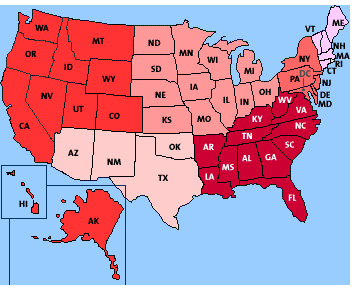 |
|
|
Travel
& Geography
> The Regions of the United States New
England | The Mid-Atlantic | The
South |
|
 |
||
Americans
often speak of their country as one of several large regions.
These regions are cultural units rather than governmental units -- formed
by history and geography and shaped by the economics, literature and
folkways that all the parts of a region share. What makes one region
different from another? A region's multicultural heritage as well as
distinct demographic characteristics like age and occupation make regions
different and special. Within several regions, language is used differently
and there are strong dialects. There are also differences in outlook
and attitude based on geography. |
||
|
New
England Connecticut | Maine | Massachusetts | New Hampshire | Rhode Island | Vermont
|
||
| Mid-Atlantic Delaware | Maryland | New Jersey | New York | Pennsylvania | Washington D.C.
|
||
| The
South Alabama | Arkansas | Florida | Georgia | Kentucky | Louisiana | Mississippi | North Carolina | South Carolina | Tennessee | Virginia | West Virginia
|
||
| Midwest
Illinois | Indiana | Iowa | Kansas | Michigan | Minnesota | Missouri | Nebraska | North Dakota | Ohio | South Dakota | Wisconsin
Farms are normally located separate from each other, close to the fields, and often beyond the sight of its neighbors. The village or town is principally a place where the farm family travels to buy supplies, to attend church and to go for entertainment or political, social or business meetings. Midwesterners are praised as being open, friendly, and straightforward. Their politics tend to be cautious, but the caution is sometimes peppered with protest. |
||
|
The
Southwest Arizona | New Mexico | Oklahoma | Texas
The population in the region is growing rapidly. Arizona, for example, now rivals the southern states as a destination for retired Americans in search of a warm climate. Since the last third of the 19th century, the immense stretch of barren American desert has been growing smaller. In the 1860s, the wasteland extended from the Mississippi Valley almost to the Pacific Coast. But settlers learned that the prairies could grow corn and that the grasslands could feed cattle and sheep or yield wheat. As they continued to cultivate the desert, its size decreased. Dams on the Colorado and other rivers and aqueducts have brought water to the once small towns of Las Vegas, Nevada, Phoenix, Arizona, and Albuquerque, New Mexico, allowing them to become metropolises. |
||
|
The West Alaska | Colorado | California | Hawaii | Idaho | Montana | Nevada | Oregon | Utah | Washington | Wyoming
The West is a region of scenic beauty on a grand scale. In much of the West, the population is sparse and the federal government owns and manages millions of hectares of undeveloped land. Americans use these areas for recreational and commercial activities, such as fishing, camping, hiking, boating, grazing, lumbering, and mining. In recent years, some local residents who earn their livelihoods on federal property have come into conflict with the government agencies, which are charged with keeping land use within environmentally acceptable limits. Hawaii is the only state in the union in which Asian Americans are the largest ethnic group. Beginning in the 1980s, large numbers of Asians have also settled in California. Los Angeles - and Southern California as a whole - bears the stamp of its large Mexican-American population. Now the second largest city in the nation, Los Angeles is best known as the home of the Hollywood film industry. Fueled by the growth of Los Angeles and the "Silicon Valley" area near San Jose, California has become the most populous of all the states. Perhaps because so many westerners have moved there from other regions to make a new start, Western cities are known for their tolerance and a very strong "live-and-let-live" attitude. |
||
| Texts
are abridged from U.S. State Department IIP
publications and other U.S. government materials. |
||
| What kind of information materials are available?
CD: These documents are available in fulltext format on the About the USA CD-ROM. Teachers: Request a copy for classroom use. L: Selected documents are available in German as well as other languages, including Arabic, Chinese, French, Spanish, Persian and Turkish. |
DISCLAIMER
Any reference obtained from this server to a specific commercial product, process, or service does not constitute or imply an endorsement by the United States Government of the product, process, or service, or its producer or provider. The views and opinions expressed in any referenced document do not necessarily state or reflect those of the United States Government. |
